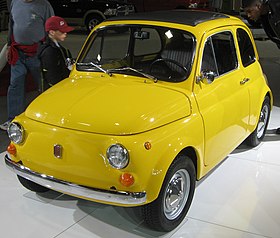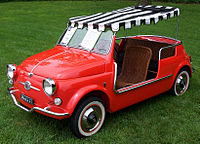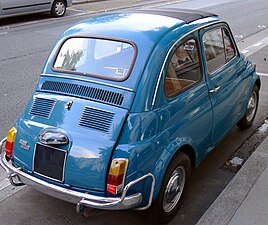
Fiat 500 1957–1975

| Fiat 500 | |
|---|---|

1970 Fiat 500
|
|
| Overview | |
| Manufacturer | Fiat |
| Production | 1957–1975 3,893,294 units |
| Assembly |
|
| Designer | Dante Giacosa |
| Body and chassis | |
| Class | City car (A) |
| Body style |
|
| Layout | Rear-engine, rear-wheel drive |
| Related |
|
| Powertrain | |
| Engine |
|
| Transmission | 4-speed manual |
| Dimensions | |
| Wheelbase | 1.84 m (72.4 in) |
| Length | 2.97 m (116.9 in) |
| Width | 1.32 m (52.0 in) |
| Height | 1.32 m (52.0 in) |
| Kerb weight | 499 kg (1,100 lb) |
| Chronology | |
| Predecessor | Fiat 500 "Topolino" |
| Successor | Fiat 126 |
The Fiat 500 (Italian: Cinquecento, Italian pronunciation: [ˌtʃiŋkweˈtʃɛnto]) is a rear-engined two-door, four seat, small city car manufactured and marketed by Fiat Automobiles from 1957 to 1975 over a single generation in 2-door saloon and 2-door station wagon bodystyles.
Launched as the Nuova (new) 500 in July 1957, as a successor to the 500 "Topolino", it was a cheap and practical little town car. Measuring 2.97 metres (9 feet 9 inches) long, and originally powered by a 479 cc two-cylinder, air-cooled engine, the 500 was still 24.5 centimetres (9.6 inches) smaller than Fiat's 600, launched two years earlier, and is considered one of the first purpose designed city cars.
In 2007, the 50th anniversary of the Nuova 500's launch, Fiat launched another new 500, stylistically inspired by the 1957 Nuova 500, featuring a front-mounted engine and front-wheel drive.
History
To meet the demands of the post-war market which called for economy cars, in 1949 a front engine Fiat 500 was released. It had a 2-door coupe body with sun-roof, which was later complemented by an Estate version. Both continued until 1954 when they were replaced by an all-new, lighter car. The new car had a rear-mounted engine, on the pattern of the Volkswagen Beetle, just like its bigger brother the 1955 Fiat 600. Several car makers followed the now uncommon rear engine configuration at the time and were quite successful. The Neckar version of the 500 was manufactured in Heilbronn under a complicated deal involving NSU, and was introduced in October 1961.Steyr-Puch produced cars based on the Fiat 500 under license in Graz, Austria.
Despite its diminutive size, the 500 proved to be an enormously practical and popular vehicle throughout Europe. Besides the two-door coupé, it was also available as the "Giardiniera" estate; this variant featured the standard engine laid on its side, the wheelbase lengthened by 10 cm (3.9 in) to provide a more convenient rear seat, a full-length sunroof, and larger brakes from the Fiat 600.
Sports models were famously produced by Abarth, as well as by Giannini. An Austrian variant, produced by Steyr-Daimler-Puch, the 1957–1973 Steyr-Puch 500, had a motorcycle-derived Puch boxer twin motor, a sports model of which was the 1965–1969 Steyr-Puch 650 TR2.
Production of the 500 ended in 1975, although its replacement, the Fiat 126, was launched two years earlier. The 126 was never as popular as its predecessor in Italy, but was enormously popular in the former Eastern Bloc countries, where it is famed for its mechanical durability and high fuel economy. The Fiat 500 has a Cx (aerodynamic resistance coefficient) of 0,38, a very good performance for its time.
Models
Nuova 500 (1957–1960)

The 500 features a 479 cc (500cc nominal) two-cylinder engine, hence the name, producing just 13 horsepower. This model also features a fabric roof, foldable to the rear of the vehicle, like that of a Citroën 2CV — rather than the later roof design, which only folds half way back along the roof. The Nuova 500 is one of three models featuring "suicide doors."
Including the Sport model, in total 181,036 examples of the Nuova 500 were produced from 1957 to 1960.
Nuova 500 Sport (1958–1960)
In mid-1958 Fiat introduced the Nuova 500 Sport, featuring a more powerful engine and a two-tone livery—white with a red stripe along the flanks. Unique to the Sport was an all-metal rigid roof with three longitudinal grooves. A short-open-roof model was added a year later, in 1959.
Coded type 110.004, the 500 Sport's two-cylinder engine had been bored out to 499.5 cc from the original 479 cc (bore and stroke now 67.4 × 70 mm), giving it a very respectable horsepower with the same block: 21.5 PS (15.8 kW; 21.2 hp). Top speed was over 105 km/h (65 mph).
500 D (1960–1965)
Replacing the original Nuova in 1960, the D looks very similar to the Nuova, but there are two key differences. One is the engine size (the D features an uprated 499 cc engine producing 17 bhp as standard—this engine is used right through until the end of the L in 1973) and the other is the roof: the standard D roof does not fold back as far as the roof on the Nuova, though it was also available as the "Transformable" with the same roof as the Nuova. The D also features "suicide doors".
In New Zealand, where it was locally assembled by Torino Motors, the 500D was sold as the "Fiat Bambina" (Italian for "baby"), a name that is still in use there to describe this car.
|
500 Giardiniera (1960–1975)

The 500 Giardiniera (500 K on some markets) estate version of the Fiat 500 is the longest running model. The engine is laid under the floor of the boot to create a flat loading surface. The roof on this model also stretches all the way to the rear, not stopping above the driver and front passenger as it does in other models of the same period. The Giardiniera also features "suicide doors" and was the only model to continue to use this door type into the 1970s. In 1966 production was transferred to Desio where the Giardiniera was built by Fiat subsidiary Autobianchi. A total of 327,000 Giardinieras were produced, later examples having Autobianchi rather than Fiat badging.
500 Furgoncino
A van variant of the Giardiniera was offered as the Furgoncino.
|
500 F or Berlina (1965–1973)
The F spans two periods of 500 production, the D and the L. As such, it is the most frequently misidentified model. Between 1965 and 1969 the F carried the same badging as the D, but the two models are distinguishable by the positioning of their door hinges. The D has "suicide doors": the F, produced from June 1965, at last featured front-hinged doors. Between 1969 and 1972 the F was sold alongside the Lusso model as a cheaper "base model" alternative. While the F and L are mechanically very similar, the key differences are the bumpers (the L has an extra chrome nudge bar) and the interior (the F interior is nearly identical to the original 1957 design while the L sports a much more modern look).
500 L or Lusso (1968–1972)
In September 1968 Fiat put on sale the 500 L or Lusso (tipo 110 F/L), a more richly trimmed and better appointed version of the standard 500 F. The 500 L remained on sale until 1972, when the new Fiat 126 was introduced.
Perhaps the most obvious new feature of the 500 L were tubular guards protecting the front bumper and the corners of the rear one. As a result, the car was about 6 cm (2.4 in) longer than the 500 F at 3,025 mm (119 in). Other model-specific exterior items were a new Fiat badge at the front, redesigned hubcaps, chrome plastic mouldings covering the roof drip rails, and bright trim around windscreen and rear window. Inside the dashboard was entirely covered in black anti-glare plastic material instead of being bare painted metal, and was fitted with a new trapezoid instrument binnacle replacing the round one used on all other 500 models. The steering wheel was black plastic with metal spokes. The door cards—upholstered in the same pleated pattern leatherette used on the seats—carried redesigned and relocated door handles and new door pockets. More storage space was provided in the form of a tray on the centre tunnel, which like the rest of the floor was covered in carpet rather than rubber mats. Except for radial instead of bias ply tires, from a mechanical standpoint the 500 L was identical to the coeval 500 F.
- Fiat 500 L
-
-
-

500 R or Rinnovata (1972–1975)
The last incarnation of the Fiat 500 was the R model. It had the same 594 cc engine of the Fiat 126, however, the power rating is the same as the L but at lower rpm (4000 instead of 4400) and with a bit more torque; a full synchromesh gearbox is still missing. The floor-pan which was from either the 'L', or later, the new 126. It was also more comfortable, but more simply trimmed and equipped than before — the fuel gauge was omitted and only the low fuel indicator remained. The 500 R was also a stop-gap for Fiat prior to the launch of the Fiat 126, and when the new 126 was launched, sales of the old Fiat 500 R plummeted. It was sold alongside the Fiat 126 for another two years before Fiat retired the 500.
|
Derivatives
Fiat 500 Jolly Ghia
Carrozzeria Ghia made a custom "Jolly" version of the 500 inspired by the limited edition Fiat 600 Jolly. As with its bigger sister, this was a chopped-roof doorless version with wicker seats, often seen sporting a canopy roof.
-

Fiat 500 Jolly by Ghia, with US-market headlights.
Fiat 500 America
During the years in which it was produced the 500 in Italy, Fiat designed and produced a US-market version of the car with prominent headlamps (also used on the American 500 Jolly) and reinforced bumpers, this rare car was destined for the US market.
Fiat New 500
First announced in May 2006, Fiat previewed an all-new four-seat three-door hatchback 500 model in March 2007 – fifty years after the first Fiat 500 was presented. The design of the 2007 Fiat 500 is based on the 2004 Fiat Trepiùno concept.
The new model features a distinctive retro style - following the pattern of the Volkswagen New Beetle and BMW MINI - as modern reinterpretation of Dante Giacosa's 1957 original rear-engined Fiat 500. Production started in mid-2007 in Fiat facilities in Tychy, Poland, and later in Toluca, Mexico. Numerous trim, equipment, and performance versions are offered with a convertible body style available starting in 2009.
The 500 is also offered in Abarth trim, with 1.4L Turbo engine, sport exhaust, suspension, and transmission.
The Fiat 500 automobile platform is the basis of the second-generation Ford Ka.







